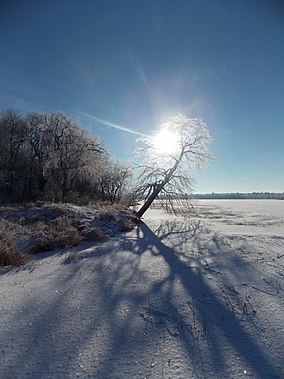Tamarac National Wildlife Refuge: Difference between revisions
Template added |
pic |
||
| Line 6: | Line 6: | ||
| map_caption = Map of the [[United States]] |
| map_caption = Map of the [[United States]] |
||
| map_width = 300 |
| map_width = 300 |
||
| photo = |
| photo = Tamarac National Wildlife Refuge.jpg |
||
| photo_caption = |
| photo_caption = |
||
| photo_width = |
| photo_width = |
||
| Line 23: | Line 23: | ||
| website = [http://www.fws.gov/refuge/tamarac/ Tamarac National Wildlife Refuge] |
| website = [http://www.fws.gov/refuge/tamarac/ Tamarac National Wildlife Refuge] |
||
}} |
}} |
||
'''Tamarac National Wildlife Refuge''' |
'''Tamarac National Wildlife Refuge''' is a [[National Wildlife Refuge]] of the United States. It lies in the glacial lake country of northwestern [[Minnesota]] in [[Becker County, Minnesota|Becker County]], {{convert|18|mi|km}} northeast of [[Detroit Lakes, Minnesota|Detroit Lakes]]. It was established in 1938 as a refuge breeding ground for migratory birds and other [[wildlife]]. It covers {{convert|42724|acre|km2}}. |
||
Local [[topography]] consists of rolling forested hills interspersed with lakes, rivers, [[marsh]]es, [[bog]]s and [[shrub]] [[swamp]]s. The token of the refuge is the [[Larix laricina|tamarack]], or tamarac tree. This unusual tree is a [[deciduous]] [[conifer]] which turns a brilliant gold before losing its needles each fall. |
|||
Tamarac National Wildlife Refuge lies in the heart of one of the most diverse vegetative transition zones in [[North America]], where northern [[hardwood]] forests, coniferous forests and the [[tallgrass prairie]] converge. This diversity of habitat brings with it a wealth of wildlife, both woodland and prairie species. |
Tamarac National Wildlife Refuge lies in the heart of one of the most diverse vegetative transition zones in [[North America]], where northern [[hardwood]] forests, coniferous forests and the [[tallgrass prairie]] converge. This diversity of habitat brings with it a wealth of wildlife, both woodland and prairie species. |
||
| Line 32: | Line 32: | ||
==References== |
==References== |
||
{{commonscat}} |
|||
| ⚫ | |||
{{Reflist}} |
{{Reflist}} |
||
{{Include-USGov |
{{Include-USGov |
||
|agency=United States Fish and Wildlife Service}} |
|agency=United States Fish and Wildlife Service}} |
||
==External links== |
|||
| ⚫ | |||
{{Protected Areas of Minnesota}} |
{{Protected Areas of Minnesota}} |
||
{{National Wildlife Refuges of the United States}} |
{{National Wildlife Refuges of the United States}} |
||
Revision as of 05:35, 22 July 2016
| Tamarac National Wildlife Refuge | |
|---|---|
IUCN category IV (habitat/species management area) | |
 | |
Map of the United States | |
| Standort | Becker County, Minnesota, United States |
| Nearest city | Detroit Lakes, Minnesota |
| Area | 42,724 acres (172.90 km2) |
| Established | 1938 |
| Governing body | U.S. Fish and Wildlife Service |
| Website | Tamarac National Wildlife Refuge |
Tamarac National Wildlife Refuge is a National Wildlife Refuge of the United States. It lies in the glacial lake country of northwestern Minnesota in Becker County, 18 miles (29 km) northeast of Detroit Lakes. It was established in 1938 as a refuge breeding ground for migratory birds and other wildlife. It covers 42,724 acres (172.90 km2).
Local topography consists of rolling forested hills interspersed with lakes, rivers, marshes, bogs and shrub swamps. The token of the refuge is the tamarack, or tamarac tree. This unusual tree is a deciduous conifer which turns a brilliant gold before losing its needles each fall.
Tamarac National Wildlife Refuge lies in the heart of one of the most diverse vegetative transition zones in North America, where northern hardwood forests, coniferous forests and the tallgrass prairie converge. This diversity of habitat brings with it a wealth of wildlife, both woodland and prairie species.
An attractive visitor center offers a spectacular vista of the marshes and trees that are typical of the Tamarac Refuge. A theater presentation provides orientation to the life and legends of this unique area.
References
![]() This article incorporates public domain material from websites or documents of the United States Fish and Wildlife Service.
This article incorporates public domain material from websites or documents of the United States Fish and Wildlife Service.

